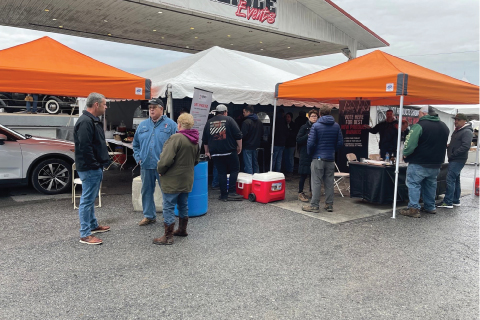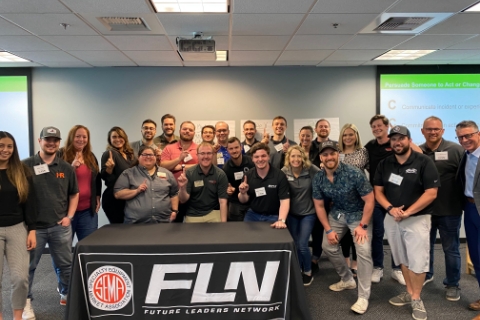SEMA Member News—September 2019
How Passion, Resolve and a SEMA Scholarship Enabled Ian McKibben to Pave a Bright Path
By Ellen McKoy
 Ian McKibben in the jet boat he built using wood stripping techniques, stitch and glue techniques and by formed fiberglass panels. The boat, named Sabatage II and painted by Justin and Lydia Montana, is powered by a big-block Chevy engine and Berkley Jet drive. Ian McKibben in the jet boat he built using wood stripping techniques, stitch and glue techniques and by formed fiberglass panels. The boat, named Sabatage II and painted by Justin and Lydia Montana, is powered by a big-block Chevy engine and Berkley Jet drive. |
Activating the next generation of aftermarket industry leaders and innovators is a hot topic nowadays, as evidenced by various SEMA outreach initiatives—some new, some long-standing—aimed at youth engagement. The oldest and one of the most impactful is the SEMA Memorial Scholarship Fund. Since the fund was established in 1984, more than $2.5 million has been awarded to more than 1,400 worthy students.
Over the years, many awardees have gone on to build careers in the aftermarket industry. But questions sometimes arise. Who are they? What do they do? Where are they now? SEMA Member News recently spoke with Ian McKibben to learn how a SEMA scholarship enabled one student to pursue a chosen career path.
Growing up in Southern California, McKibben was immersed in the world of drag racing from an early age through a family connection to the legendary father-son team of Chet and Doug Herbert of Herbert Cams and Doug Herbert Racing fame. So it’s not surprising that McKibben’s first “job” was working on a nitro funny car. During high school, he worked part time learning the ropes at SO-CAL Speed Shop.
Having graduated from the Savannah College of Art and Design with a major in industrial design, McKibben recently returned from England, where he spent 18 months teaching industrial design at Radley College. Upon returning stateside, he rejoined the SO-CAL team—where he had continued working during school breaks—while also pursuing his entrepreneurial fervor as the owner of Roadster Supply, a fledging Southern California business that already represents several top hot-rod brands and produces its own traditional hot-rod products.
But to hear McKibben tell it, his pathway to an automotive career wasn’t necessarily a sure thing.
“I was involved in the industry my whole life,” he said. “I didn’t really have a choice, because my dad worked for Chet and Doug Herbert. Throughout high school, I worked at SO-CAL Speed Shop doing just grunt work. Then I began working with Dennis Nosworthy, a big player at SO-CAL who made all the parts. He started teaching me how to make the parts, why they were made the way they were, and how it all fit together in the car.
“After a while, I was able to make everything that SO-CAL designed. So I first thought I wanted to do transportation design because I love cars. But then I realized I really prefer making the parts. So I went to design school, where I tried to stay away from automotive things, just to test the waters and find out what I really wanted to do.”
An Ah-Ha Moment
McKibben tried his hand at several student projects. He designed new Koozie coffee cups and went on to make power tools and to design furniture. But he soon decided to tackle something different—building a wooden kayak.
“I remember sitting down with my teacher,” McKibben said. “He asked how I was going to make the kayak better. I said the problem was that it didn’t have an engine. I wanted to build something that would go fast. The kayak was boring and slow. I wanted to build a
speed boat.”
What happened next was a turning point.
“That boat project made me think back to my time doing the funny car and working at So-Cal, making all those parts,” he said. “That’s when I realized what I really wanted to do. I spent the rest of my time in college doing just that, and for my senior thesis, I made a traditional-style go kart with brand-new billet components, fully adjustable and powered by graphene batteries, just to test my creativity.”
Paving the Way
 The interior of McKibben’s jet board is fitted with a ’32 Ford-style dash and custom wrap-around seats that he made himself. The project would never have been completed had McKibben not received the SEMA scholarship award. The interior of McKibben’s jet board is fitted with a ’32 Ford-style dash and custom wrap-around seats that he made himself. The project would never have been completed had McKibben not received the SEMA scholarship award. |
Like so many of today’s college students, McKibben relied on student loans to help offset tuition costs and other expenses. But loans stretch only so far, and though he had heard about the SEMA scholarship program, he had been told that his industrial design major didn’t fit the scholarship criteria.
“A few of my friends who were interested in the automotive industry talked about the SEMA scholarship,” he said. “But whenever I would ask, they’d say I didn’t qualify because I was not doing transportation design.”
McKibben was determined to prove them wrong. He submitted his scholarship application to SEMA with an essay explaining in detail “how product design, especially in the aftermarket products industry, is a more effective major than transportation design.” Around the same time, he also applied for the Buick Achievers Scholarship, relying on the same talking points in his application.
It turned out to be a powerful line of reasoning.
In 2016, McKibben was awarded a $3,000 SEMA scholarship and a whopping $25,000 award from Buick. All the money he received from Buick went toward paying his remaining tuition fees, but it was the SEMA award that really made an impact.
“When I received the SEMA award, I was building my jet boat,” McKibben said. “It was the most opportune time, because it cost so much and it was really a struggle. I was at the point where I wasn’t able to pay my bills, so that scholarship was the extra boost. It actually helped me finish the boat, get it in the water and finish the class. I could not have completed that course without that scholarship.
“I was definitely very fortunate. I did still graduate with quite a few student loans, but I certainly got a lot of help from scholarships. And that’s the important thing to remember. It’s all about opportunities, and you have to go after them. It’s so easy for someone to tell you that a scholarship doesn’t apply to you. The worst that can happen is someone will say no. But if you get it, it just might make the difference in being able to graduate or not graduate and not becoming the person you want to be.”








